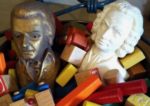Creativity & Method: Redux
 It’s the start of the school year and with it has come much discussion among colleagues, questions from new students, and personal observations about transfer student readiness. I have read several posts and even a rant or two against piano methods in general. I find this very disturbing. Everyone who knows me knows that I like to think out of the “lines and spaces” and that I’m very much against uni-taskers. Using a method well means knowing how the pieces and skills tie in to the requirements of later repertoire. Using it any other way, in my opinion, is creating a situation of pure chance that the student will make the correct connections.
It’s the start of the school year and with it has come much discussion among colleagues, questions from new students, and personal observations about transfer student readiness. I have read several posts and even a rant or two against piano methods in general. I find this very disturbing. Everyone who knows me knows that I like to think out of the “lines and spaces” and that I’m very much against uni-taskers. Using a method well means knowing how the pieces and skills tie in to the requirements of later repertoire. Using it any other way, in my opinion, is creating a situation of pure chance that the student will make the correct connections.
So, I offer you this piece of vintage PA, from July of 2010, along with some additional material and links to the rest of my series on Methods to Style. The series was adapted from a large project I undertook as part of my pedagogy studies. In it, I gave examples of ways in which methods can be used creatively to prepare students for advancing literature. It was not my intention to compare methods or to endorse any particular method. I hoped that looking at examples from the first two levels of various lesson books would help teachers consider method books in a fresh, creative way.
Martin has studied the piano for 4 years and a few months. He has finished the traditional method and supplementary books and is eagerly exploring music of many styles. Along with learning pieces from the standard repertoire, Martin loves to compose and improvise. He plays at a retirement home during school vacations and he and his friends have started a band.
* * *
Carolyn has studied piano for 5 1/2 years. She has dutifully learned every piece in her method books. Carolyn and her teacher worked on a Baroque dance and a Jazz piece recently but the struggle was so great and Carolyn was so uncomfortable that she and her teacher put aside the pieces and decided to work only in the last two levels of her method series.
* * *
The above two examples are clearly stereotypes. We have all met Martin and Carolyn plus a multitude of students who share traits from both. Why should Martin have moved successfully through the method books and into intermediate study while Carolyn is seemingly dependent on those same books? As seen from the illustrations below, Martin has successfully transitioned into the broader world of music while Carolyn has hit the proverbial brick wall.
Certainly, individual personality traits and degrees of talent, interest, discipline, and motivation have an influence on these diverse outcomes. The family’s musical tastes and expectations are also a factor. A student’s family provides a major source of support and encouragement for the student. The music that is heard (or not heard) in the home provides a basis to build upon during lessons. The expectations that parents hold for music lessons (an emotional outlet, a good habit builder, the basis for a lifetime of musical learning and enjoyment, or something in between) also weigh into the balance.
It is very tempting to rationalize our success or non success with a student on these items alone. They can help or undermine our finest efforts and there are instances in every teacher’s career when one must acknowledge that the success of a student is not within our control. However, there is another important influence present in every teaching situation. One that we, as teachers, can personally control—our own (the teacher’s) expectations for lessons.
I was pursuing the old inter-web one morning and came across an interview with Montreal pianist, André Laplante. In it Mr. Laplante touches on the difference between piano performance and art. He bemoans technique over artistry and describes himself as squirming in his seat as a juror in the 1994 Tschaikowsky Competition because “there was lots of doing- but music…” (the journalist suggests a Gallic shrug here). He is described as encouraging a goal, at all levels, of accepting the higher challenge of getting music from sound rather than just getting sound out of the piano.
There was also a distinct dissing of piano methods from Mr. Laplante who seemed to feel them too corporate and divorced from artistry. I disagree. Sorry all you authors out there, but method books are tools and nothing more. Sorry all you teachers out there, but if method books are resulting in a divorce from artistry, the fault it is how these tools are being used. It all comes down to using the tools you are given creatively. Methods are not uni-taskers!
I spend a lot of time in my preparation for teaching, workshops, and writing on the possibilities of method books- in other words, using a method creatively. Publishers and authors don’t tell you this kind of stuff during conference sessions or in teacher guides where the emphasis is on the concepts and skills contained in each level.
Method books are fabulous at helping prepare students for intermediate literature. They are elementary musical gold mines. Transition is the issue. To effect positive transitions from methods to repertoire to artistic performance we need to creatively understand the possibilities of method books- we need to think out of the lines my friends.
Do we as teachers see where the road ahead leads? Are we asking ourselves how what we are teaching today forms the basis for learning that Jazz piece or that Baroque dance, for producing that magical, artistic performance, or for creating that improvisation or original composition? Are we observing each student’s unique personal characteristics and teaching first to that perspective? Are we using the tools we have been given in a creative manner? Perhaps the following posts can be of some help. Feel free to print them for convienence.
Piano Addict Methods to Style Posts
Here’s to <re@t!v!ty!
BTW: I was forced to put this here at the end of the post because WordPress decided that if I was going to be creative in my title it would just not include it. How very in the lines of them.
Here’s some more food for thought from Newsweek, The Creativity Crisis.



Jane Tan once said to me: Would you rather have your child spend an entire semester learning one epic poem by heart or would you rather have them read and create many little stories in many subjects?
Method books are like reading books to early readers. Do we want our students to stay in the reading books as long as possible or be free to read, create, and understand anything they want that is appropriate?
Well, I did say they were stereotypes. However, you are right that there is a spectrum here. No one is all Carolyn or all Martin. The really intuitive and “talented” student will make the connections between early experiences and later literature with little need for help but in order to transition out of method books, most students need the teacher to understand how each activity relates to real repertoire (what pieces/activities strengthen what). Most students don’t ever go through all the levels before they are able to make that transition. I take issue with the use of method books to teach rhythm and note reading only, with occasional forays into beautiful tones and musical meaning for recital pieces. When I get students who have been taught that way it takes quite some time to move them to a new way of thinking and learning.
“Martin has successfully transitioned into the broader world of music while Carolyn has hit the proverbial brick wall.”
There’s also a tendency to forget that kids progress at different rates, and that Martin will eventually hit a brick wall of some sort — that’s a lead-pipe cinch. Everyone hits walls. Martin hasn’t hit one so far … but he will. And a whole new musical life may be waiting for Carolyn on the other side of her brick wall.
The only real problem I tend to see for a lot of classical music teachers (and I think it’s a common thing for teachers in general) is that they forget that they are seeing their students for a relatively tiny slice of their lives. And especially in a world where you’re considered worthless and over the hill at age 9, the tendency is to consider a kid a failure if they don’t progress at the recommended level right now. How do we know when Carolyn will get over that brick wall or what’s waiting for her on the other side of it? And who knows what curve balls Martin’s life will throw at him?